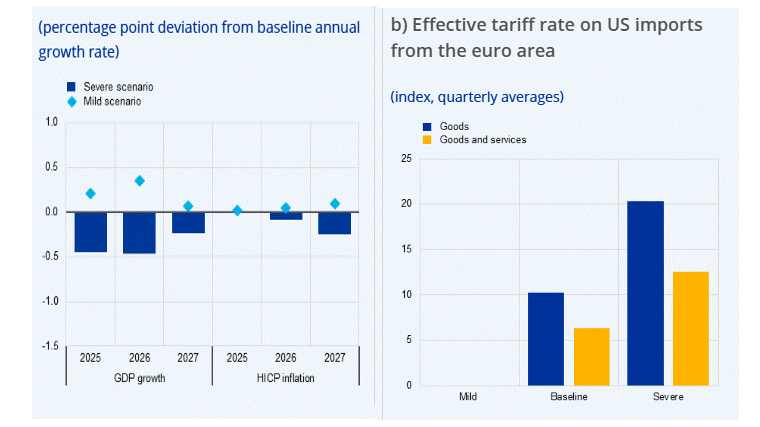U.S.-EU Trade Agreement: More a Framework Than a full Deal
In what seems to have been a fully-fledged political capitulation to the U.S. the EU, it seems, is accepting an agreement that would see an almost-blanket reciprocal 15% tariff on its exports to the U.S. But there still some imponderables, not least the range of sectoral concessions, whether EU member states will back the deal and the extent to which the result of its 232 trade investigations in two weeks will actually decide separately on tariff rates for the likes of chips and pharmaceuticals. Thus, this is more a framework than a formal deal, and thus while it may moderate what is global trade uncertainty, it will not end it. Regardless, a circa-15% deal will be seen by most as damage limitation on behalf of the EU in order to avoid an even more punitive 30% tariff that had been threatened. But in what may turn out to be more than 15% effectively, any such tariff is more than the 10% rate the EU thought it would get just a few weeks ago and which forms the baseline for the ECB’s existing forecasts - something the latter clings to for the time being.
Figure 1: The ECB Tariff Scenario – EU ‘Deal’ More Like Severe than Baseline?

Source: ECB June forecasts - baseline sees GDP growth of 0.9% (25), 1.1% (26) & 1.3% (27)
But, although it is uncertain what the impact will be, we think that according to its recent scenario pictures, when the ECB updates its forecasts at the Sep 11 decision, it should be reining in both its inflation and growth outlooks more in line with its severe scenario (Figure 1). Indeed, the ECB largely sees tariffs as being disinflationary for the EZ and even if a trade deal is reached it may merely reduce current uncertainty not end it nor repair the damage it will cause. Unless business surveys due in the interim improves markedly (not our expectation), this tariff damage we envisage, should trigger a 25 bp cut on Sep 11, not least as the core 2026 and 2027 HICP readings are already down to 1.9%. But the Council will be divided as likely comments due in coming weeks may illustrate.
It is clear that the U.S.is ‘trumping’ how good this deal is for itself Trump told reporters, lauding this now includes EU plans to invest some USD 600 bn in the United States and dramatically increase its purchases of U.S. energy and military equipment by an even larger amount allegedly during the rest of the current Trump presidential term. NB: this could largely remove the trade in goods surplus the EU has over the U.S.! However, buying more LNG from the U.S. suits the EU push to stop Russian LNG gas imports, while some U.S. military hardware is unique and needed by EU NATO countries – also note Japan USD 550 bln investment in the U.S. is mainly loan and loan guarantees and only around 1-2% actual investment. In contrast, President of the European Commission Von der Leyen, said the 15% tariff applied "across the board", later telling reporters it was "the best we could get." Whether it will bring the stability and predictability, she said is more a moot point, not least as the EU faces the real threat of other countries, which are suffering similarly imbalanced trade deals, dumping exports into Europe that would otherwise be U.S. bound. Furthermore, as Canada and Mexico can testify, a “deal” with Trump is no stable settlement eve when it comes to allegedly legally binding international treaty entered into by Trump himself such as the USMCA trade agreement. Even the “deal” with Japan, all of one week old, is now seeing Japanese officials say there was no written agreement and no legally binding one would be drawn up. So this trade agreement between the EU and the U.S. is anything like an ultimate resolution.
Moreover, as the Trump administration has launched probes into industries including aerospace, pharmaceuticals and semiconductors, any of which could result in new and/or extended tariffs; the extent to which the result of its 232 trade investigations in two weeks will actually and ultimately could make the U.S. decide separately on tariff rates for the likes of chips and pharmaceuticals. However, while U.S. officials have said that the 15% covers chips and pharmaceuticals, which gives the EU some protection,Trump has later said he has yet to decide on the matter.
As for those details, it seems almost all EU goods entering the U.S. will be subject to a 15% baseline tariff, including cars, which currently face 27.5% but where a 50% tariff on steel/aluminium will remain. There will apparently be zero-for-zero tariffs on all aircraft and their components, certain chemicals, certain generic drugs, semiconductor equipment, some agricultural products, natural resources and critical raw materials. More products would be added but what will happen in regard to spirits is still to be established. Indeed, in this regard, and as von der Leyen admitted, whatever U.S. decisions come later on sectors will be "on a different sheet of paper". As a result, the deal is not final, with von der Leyen confirming several key details still need to be resolved. And while her European Commission is expected to secure sufficient support from national governments, specific provisions could still prompt push-back from individual governments – French and Dutch reservations have already been flagged.
Combined with the Japan deal, the spotlight now falls on Canada and Mexico negotiations before the August 1 deadline. Meanwhile, U.S. Treasury secretary Bessant has hinted at an extension to the August 12 China deadline during today’s U.S./China talks in Stockholm.